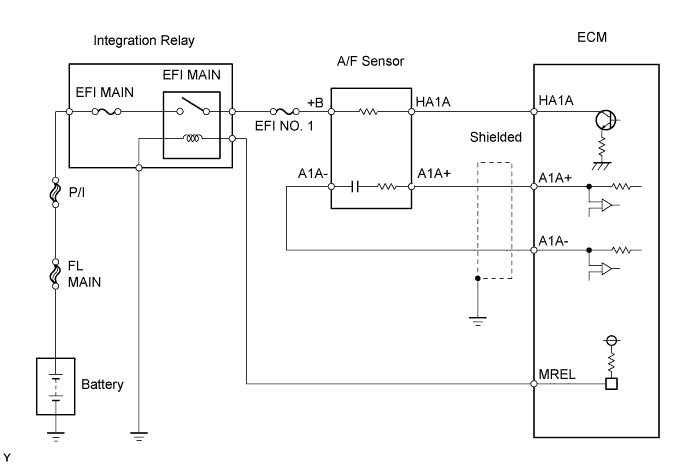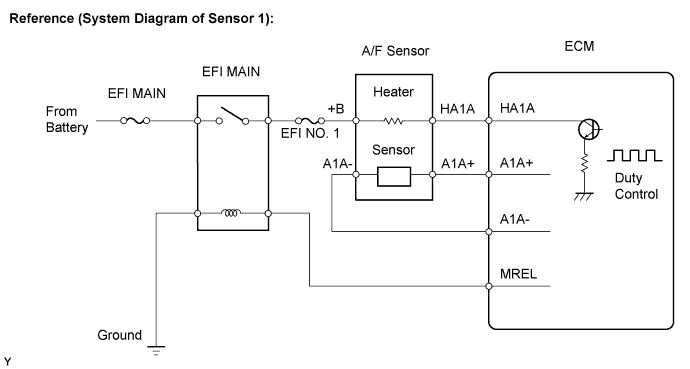INSPECT AIR-FUEL RATIO SENSOR (HEATER RESISTANCE)
INSPECT INTEGRATION RELAY (EFI MAIN RELAY)
CHECK HARNESS AND CONNECTOR (A/F SENSOR - ECM)
CHECK WHETHER DTC OUTPUT RECURS
DTC P2238 Oxygen (A/F) Sensor Pumping Current Circuit Low (Bank 1 Sensor 1) |
DTC P2239 Oxygen (A/F) Sensor Pumping Current Circuit High (Bank 1 Sensor 1) |
DTC P2252 Oxygen (A/F) Sensor Reference Ground Circuit Low (Bank 1 Sensor 1) |
DTC P2253 Oxygen (A/F) Sensor Reference Ground Circuit High (Bank 1 Sensor 1) |
DESCRIPTION
- HINT:
- Although the DTC titles say oxygen sensor, these DTCs relate to the Air-Fuel Ratio (A/F) sensor.
- Sensor 1 refers to the sensor mounted in front of the Three-Way Catalytic Converter (TWC) and located near the engine assembly.
| DTC No. | DTC Detection Condition | Trouble Area |
| P2238 |
(2 trip detection logic): (a) AF+ voltage 0.5 V or less (b) (AF+) - (AF-) = 0.1 V or less
(2 trip detection logic) |
|
| P2239 | AF+ voltage more than 4.5 V for 5.0 seconds or more (2 trip detection logic) |
|
| P2252 | AF- voltage 0.5 V or less for 5.0 seconds or more (2 trip detection logic) |
|
| P2253 | AF- voltage more than 4.5 V for 5.0 seconds or more (2 trip detection logic) |
|
MONITOR DESCRIPTION
The Air-Fuel Ratio (A/F) sensor varies its output voltage in proportion to the air-fuel ratio. If the A/F sensor impedance (alternating current resistance) or output voltage deviates greatly from the standard range, the ECM determines that there is an open or short in the A/F sensor circuit.WIRING DIAGRAM

INSPECTION PROCEDURE
- HINT:
- Intelligent tester only:
- Malfunctioning areas can be identified by performing the Control the Injection Volume for A/F Sensor function provided in the Active Test. The Control the Injection Volume for A/F Sensor function can help to determine whether the Air-Fuel Ratio (A/F) sensor, Heated Oxygen (HO2) sensor and other potential trouble areas are malfunctioning.
- (a) Connect the intelligent tester to the DLC3.
- (b) Start the engine and turn the tester ON.
- (c) Warm up the engine at an engine speed of 2,500 rpm for approximately 90 seconds.
- (d) On the tester, select the following menu items: Powertrain / Engine and ECT / Active Test / Control the Injection Volume for A/F Sensor.
- (e) Perform the Control the Injection Volume for A/F Sensor operation with the engine idling (press the RIGHT or LEFT button to change the fuel injection volume).
- (f) Monitor the output voltages of the A/F and HO2 sensors (AFS B1 S1 and O2S B1 S2) displayed on the tester.
- HINT:
- The Control the Injection Volume for A/F Sensor operation lowers the fuel injection volume by 12.5% or increases the injection volume by 25%.
- The sensors react in accordance with increases and decreases in the fuel injection volume.
- Standard:
Tester Display
(Sensor)Injection Volume Status Voltage AFS B1 S1
(A/F)+25% Rich Less than 3.0 -12.5% Lean More than 3.35 O2S B1 S2
(HO2)+25% Rich More than 0.5 -12.5% Lean Less than 0.4
- NOTICE:
- The A/F sensor has an output delay of a few seconds and the HO2 sensor has a maximum output delay of approximately 20 seconds.
| Case | A/F Sensor (Sensor 1) Output Voltage | HO2 Sensor (Sensor 2) Output Voltage | Main Suspected Trouble Area |
| 1 |  |  | - |
| 2 |  |  |
|
| 3 |  |  |
|
| 4 |  |  |
|
- Following the Control the Injection Volume for A/F Sensor procedure enables technicians to check and graph the output voltages of both the A/F and HO2 sensors.
- To display the graph, select the following menu items on the tester: Powertrain / Engine and ECT / Active Test / Control the Injection Volume for A/F Sensor / Enter / View / AFS B1 S1 and O2S B1 S2.
- HINT:
- Read freeze frame data using the intelligent tester. Freeze frame data records the engine condition when malfunctions are detected. When troubleshooting, freeze frame data can help determine if the vehicle was moving or stationary, if the engine was warmed up or not, if the air-fuel ratio was lean or rich, and other data from the time the malfunction occurred.
| 1.INSPECT AIR-FUEL RATIO SENSOR (HEATER RESISTANCE) |
 |
Disconnect the B7 A/F sensor connector.
Measure the resistance of the A/F sensor connector.
- Standard resistance:
Tester Connection Specified Condition HA1A (1) - +B (2) 1.8 Ω to 3.4 Ω at 20°C (68°F) HA1A (1) - A1A- (4) 10 kΩ or higher
Reconnect the A/F sensor connector.
|
| ||||
| OK | |
| 2.INSPECT INTEGRATION RELAY (EFI MAIN RELAY) |
Remove the integration relay from the engine room relay block.
Inspect the EFI MAIN fuse.
Remove the EFI MAIN fuse from the integration relay.
Measure the EFI MAIN fuse resistance.
- Standard resistance:
- Below 1 Ω
Reinstall the EFI MAIN fuse.

Inspect the EFI MAIN relay.
Measure the EFI MAIN relay resistance.
- Standard resistance:
Tester Connection Specified Condition 1C-1 - 1A-4 10 kΩ or higher Below 1 Ω
(Apply battery voltage between terminals 1A-2 and 1A-3)
Reinstall the integration relay.
|
| ||||
| OK | |
| 3.CHECK HARNESS AND CONNECTOR (A/F SENSOR - ECM) |
 |
Disconnect the B7 A/F sensor connector.
Turn the ignition switch on (IG).
Measure the voltage between the +B terminal of the A/F sensor connector and body ground.
- Standard voltage:
Tester Connection Specified Condition +B (B7-2) - Body ground 9 to 14 V
Turn the ignition switch off.
Disconnect the B32 ECM connector.
Measure the resistance.
- Standard resistance (Check for open):
Tester Connections Specified Conditions HA1A (B7-1) - HA1A (B32-109) Below 1 Ω A1A+ (B7-3) - A1A+ (B32-112) Below 1 Ω A1A- (B7-4) - A1A- (B32-113) Below 1 Ω
- Standard resistance (Check for short):
Tester Connections Specified Conditions HA1A (B7-1) or HA1A (B32-109) - Body ground 10 kΩ or higher A1A+ (B7-3) or A1A+ (B32-112) - Body ground 10 kΩ or higher A1A- (B7-4) or A1A- (B32-113) - Body ground 10 kΩ or higher
Reconnect the ECM connector.
Reconnect the A/F sensor connector.

|
| ||||
| OK | |
| 4.REPLACE AIR FUEL RATIO SENSOR |
| NEXT | |
| 5.CHECK WHETHER DTC OUTPUT RECURS |
Connect the intelligent tester to the DLC3.
Turn the ignition switch on (IG) and turn the tester ON.
Clear DTCs (RAV4_ACA30 RM000000PDK0AJX.html).
Start the engine.
Allow the engine to idle for 5 minutes or more.
Select the following menu items: Powertrain / Engine and ECT / DTC.
Read pending DTCs.
- Result:
Display (DTC Output) Proceed to No output A P2238, P2239, P2252 or P2253 B
|
| ||||
| A | ||
| ||